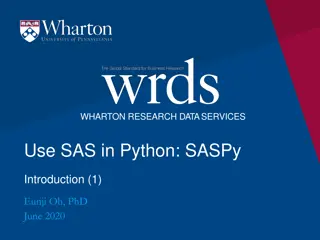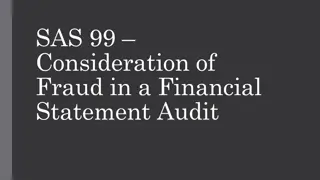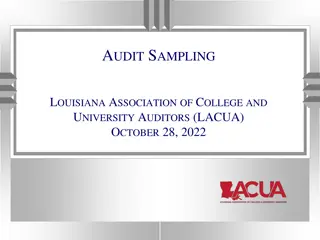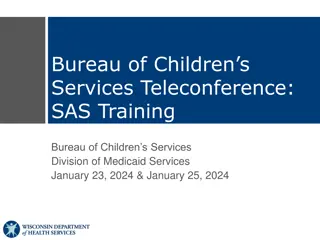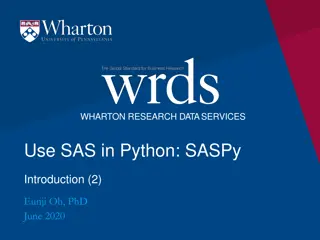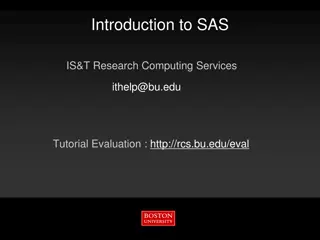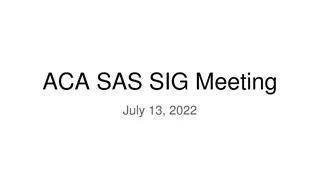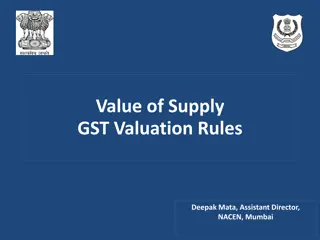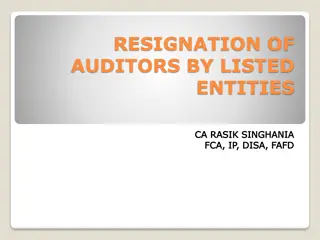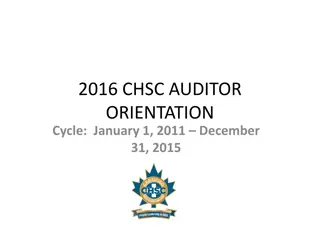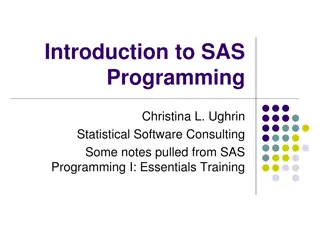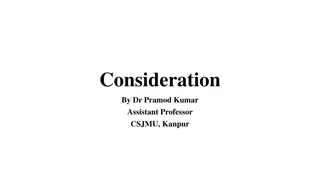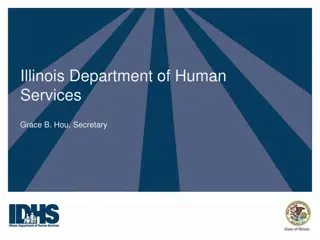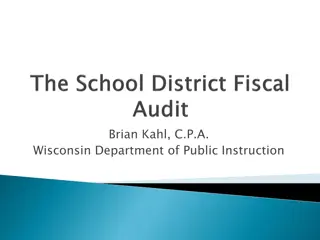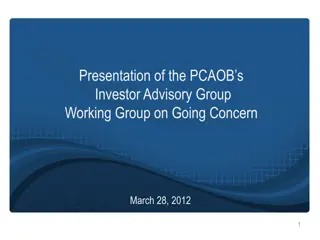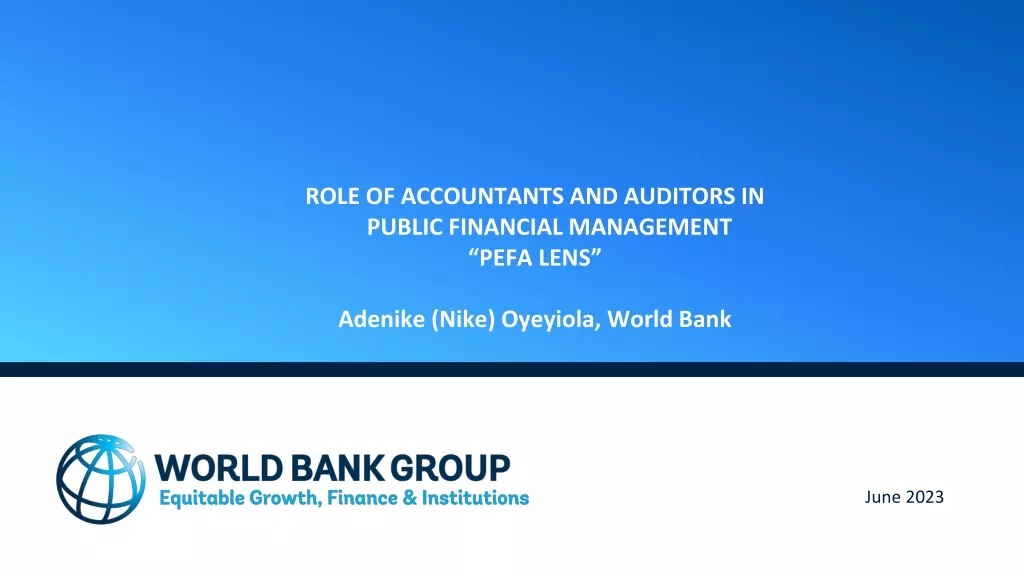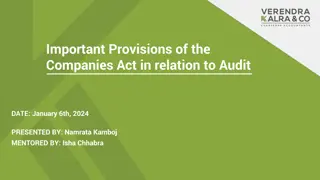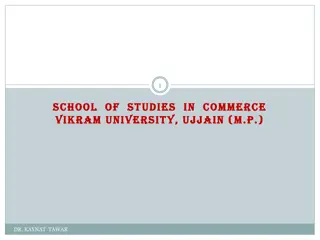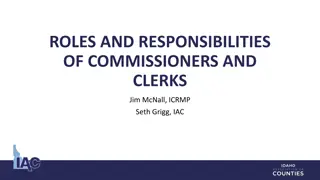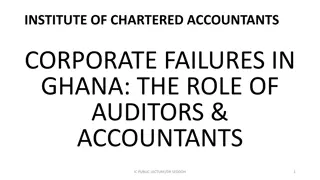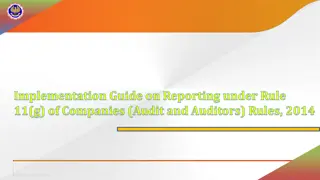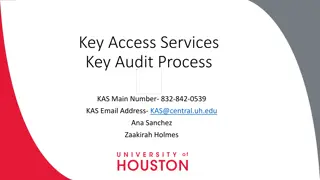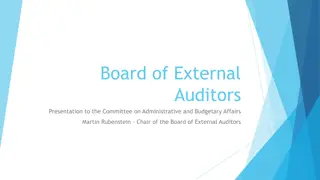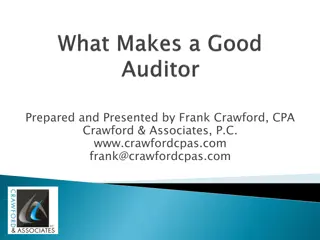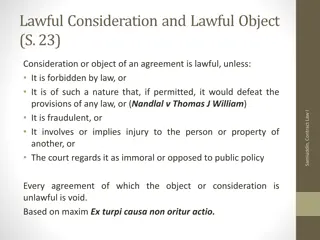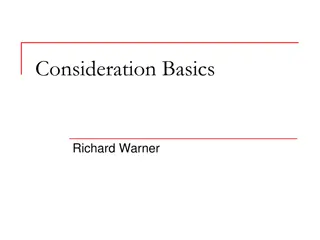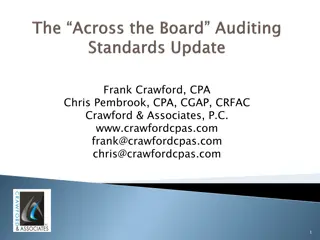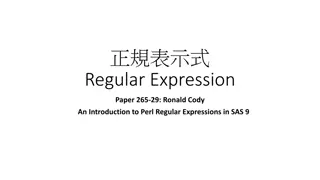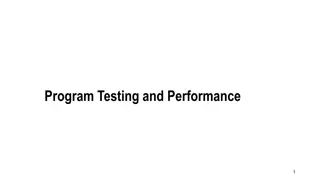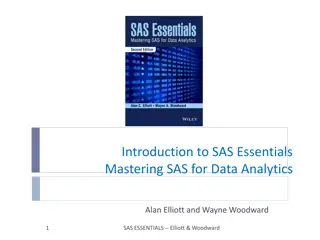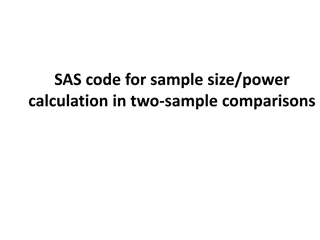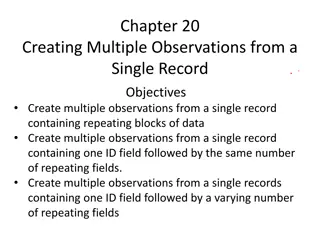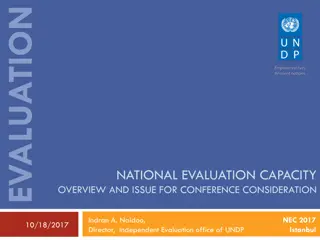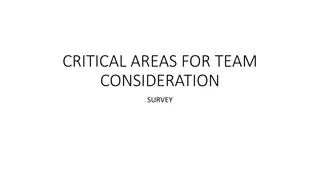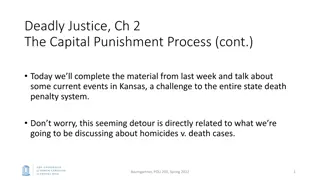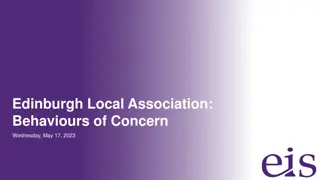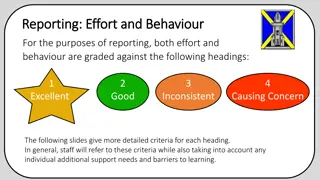Understanding SAS 132: Auditors' Consideration of Going Concern
The recently issued SAS 132 supersedes SAS 126 and focuses on auditors' evaluation of the entity's ability to continue as a going concern. It outlines the objectives, changes required, evaluation period, addressing significant delays in issuance, and reporting on the use of going concern basis of accounting. Auditors must consider substantial doubt, perform additional procedures if necessary, and issue an adverse opinion if the use of going concern basis is inappropriate.
Uploaded on Sep 29, 2024 | 0 Views
Download Presentation

Please find below an Image/Link to download the presentation.
The content on the website is provided AS IS for your information and personal use only. It may not be sold, licensed, or shared on other websites without obtaining consent from the author. Download presentation by click this link. If you encounter any issues during the download, it is possible that the publisher has removed the file from their server.
E N D
Presentation Transcript
Agenda Item 5A Auditing Standards Board Activities October 2017
Recently Issued Auditing Standards
SAS 132, The Auditors Consideration of the Entity s Ability to Continue as a Going Concern Supersedes SAS 126 of the same title Issued February 2017 Effective for periods ending on or after December 15, 2017
SAS 132, Going Concern Objectives Going Concern Basis of Accounting Ability to Continue as a Going Concern Adequacy of Disclosures Report Accordingly
SAS 132, Going Concern - Changes Required to ask about period beyond management s assessment Financial statements prepared in accordance with a special- purpose framework Going concern basis may not be relevant Need to consider if substantial doubt exists
SAS 132 Going Concern - Evaluation ASB The period of time required by the applicable financial reporting framework OR If no such requirement exists, within one year after the date that the financial statements are issued FASB Within one year after the date that the financial statements are issued GASB 12 months beyond the date of the financial statements
SAS 132 Going Concern Evaluation: Significant Delay in Issuance Auditor should inquire about the reasons for the delay. If the auditor believes that the delay could be related to the evaluation of whether there is substantial doubt about the entity s ability to continue as a going concern, the auditor should perform additional audit procedures as necessary consider the effect on the auditor s conclusion regarding the existence of substantial doubt about the entity s ability to continue as a going concern for a reasonable period of time
SAS 132, Going Concern Reporting Use of Going Concern Basis of Accounting Is Inappropriate Adverse Opinion If the financial statements have been prepared using the going concern basis of accounting but, in the auditor s judgment, management s use of the going concern basis of accounting in the preparation of the financial statements is inappropriate #AICPAgov
SAS 132, Going Concern Reporting Use of the Going Concern Basis of Accounting Is Appropriate But Conditions and Events Have Been Identified Emphasis of Matter Paragraph: If, after considering identified conditions or events and management s plans, the auditor concludes that substantial doubt about the entity s ability to continue as a going concern for a reasonable period of time remains Adverse or Qualified Opinion: If adequate disclosure about an entity s ability to continue as a going concern for a reasonable period of time is not made in the financial statements Other Impacts: If management is unwilling to perform or extend its evaluation to meet the period of time required by the applicable financial reporting framework when requested to do so by the auditor, the auditor should consider the implications for the auditor s report.
SAS 132, Going Concern Impact on AU-C 930 AU-C 930, Interim Financial Information, amended Required procedures for when the applicable financial reporting framework does, or does not, require management to evaluate going concern for interim periods Emphasis-of-matter paragraphs required under specified circumstances
SAS 133, Auditor Involvement with Exempt Offering Documents Issued July 2017 Effective for exempt offering documents that are initially distributed, circulated, or submitted on or after June 15, 2018 #AICPAgov
SAS 133 - Involvement 1. Auditor s report (financial statement or review on interim) is included or incorporated by reference in an exempt offering document -AND- 2. Auditor performs one or more of the trigger activities with respect to the offering document
SAS 133: Triggering Activities Trigger activities are Assisting the entity in preparing information included in the offering document Reading a draft of the offering document at the entity s request Issuing a comfort letter Participating in due diligence discussions Issuing an attestation report on information relating to the exempt offering Providing written agreement for the use of the auditor s report in the offering document Updating the auditor s report for inclusion in the offering document
SAS 133 - Requirements When Involved Other Information: Perform the procedures described in paragraphs .06 .18 of AU-C section 720, Other Information in Documents Containing Audited Financial Statements, on the exempt offering document Subsequent Events/Subsequently Discovered Facts: Perform procedures designed to identify events occurring between the date of the auditor s report and the date of the distribution, circulation, or submission of the exempt offering document that, had they been known to the auditor as of the date of the auditor s report, may have caused the auditor to revise the auditor s report (subsequent events).
Recent Exposure Drafts & Current Projects #AICPAgov
Auditor Reporting EBP ERISA audits Proposed new AU-C section (703) Revisions to auditor s report on ERISA plan financial statements to enhance audit quality and provide better insight into responsibilities of management and the auditor Proposed SAS includes: Form and content of unmodified opinion (AU-C 700 would no longer apply for ERISA plans) Comment Period Ended September 29, 2017 Procedures and new opinion for ERISA limited scope audit Procedures and reporting requirements on findings from procedures performed on specific plan provisions relating to the financial statements #AICPAgov
Auditor Reporting EBP ERISA audits The new form of report in the proposed SAS would require A new Basis for Limitation on the Scope of the Audit section Expanded management and auditor responsibilities sections A special form of opinion on the ERISA plan financial statements that includes: the audit procedures performed on the information not covered by the certification, management s obtaining of an appropriate certification that is provided to the auditor, and the procedures performed on the certified information, as required by the proposed SAS
Proposed SAS: Auditor Reporting Exposure Draft Expected to be Available October 2017 Goal Enhancing the communicative value and relevance of the auditor s report New section Amends 701: Communicating Key Audit Matters in the Independent Auditor s Report 700 705 706 260 570
Proposed SAS: Auditor Reporting Opinion section mandated first New sections: Key Audit Matters -- Optional to include but requirements if opt to include What keeps the auditor up at night Expanded descriptions of auditor and management responsibility, including relating to going concern Other Information When presented with the audited financial statements Other proposed improvements to enhance transparency and clarify responsibilities #AICPAgov
Proposed SAS: Illustrative Report INDEPENDENT AUDITOR S REPORT [Appropriate Addressee] Opinion We have audited the financial statements of ABC Company, which comprise the balance sheet as of December 31, 20X1, and the related statements of income, changes in stockholders equity and cash flows for the year then ended, and the related notes to the financial statements. In our opinion, the accompanying financial statements present fairly, in all material respects, the financial position of ABC Company as of December 31, 20X1, and the results of its operations and its cash flows for the year then ended in accordance with accounting principles generally accepted in the United States of America.
Proposed SAS: Illustrative Report Basis for Opinion We conducted our audit in accordance with auditing standards generally accepted in the United States of America. Our responsibilities under those standards are further described in the Auditor s Responsibilities for the Audit of the Financial Statements section of our report. We are independent of ABC Company and have fulfilled our other ethical responsibilities in accordance with the relevant ethical requirements relating to our audit. We believe that the audit evidence we have obtained is sufficient and appropriate to provide a basis for our opinion.
Proposed SAS: Illustrative Report Key Audit Matters [Not Required May be Included at the Auditor s Discretion] Key audit matters are those matters that were communicated with those charged with governance and, in our professional judgment, were of most significance in our audit of the financial statements of the current period. These matters were addressed in the context of our audit of the financial statements as a whole, and in forming our opinion thereon, and we do not provide a separate opinion on these matters. [Description of each key audit matter in accordance with AU-C 701.]
Proposed SAS: Illustrative Report Other Information [or another title if appropriate such as Information Other than the Financial Statements and Auditor s Report Thereon ] [Reporting in accordance with the reporting requirements in proposed SAS The Auditor s Responsibilities Relating to Other Information Included in Annual Reports see Illustration 1 in appendix of that proposed SAS.]
Proposed SAS: Illustrative Report Responsibilities of Management and Those Charged with Governance for the Financial Statements Management is responsible for the preparation and fair presentation of the financial statements in accordance with accounting principles generally accepted in the United States of America; this includes the design, implementation and maintenance of internal control relevant to the preparation and fair presentation of financial statements that are free from material misstatement, whether due to fraud or error. In preparing the financial statements, management is responsible for assessing the Company s ability to continue as a going concern in accordance with accounting principles generally accepted in the United States of America, and using the going concern basis of accounting unless management either intends to liquidate ABC Company or to cease operations, or has no realistic alternative but to do so. Those charged with governance are responsible for overseeing ABC Company s financial reporting process.
Proposed SAS: Illustrative Report Auditor s Responsibilities for the Audit of the Financial Statements Our objectives are to obtain reasonable assurance about whether the financial statements as a whole are free from material misstatement, whether due to fraud or error, and to issue an auditor s report that includes our opinion. Reasonable assurance is a high level of assurance, but is not absolute assurance and therefore not a guarantee that an audit conducted in accordance with generally accepted auditing standards will always detect a material misstatement when it exists. Misstatements can arise from fraud or error and are considered material if, individually or in the aggregate, they could reasonably be expected to influence the economic decisions of users taken on the basis of these financial statements. As part of an audit in accordance with GAAS, we exercise professional judgment and maintain professional skepticism throughout the audit. We also:
Illustrative Report Further Description of Auditor s Responsibilities for the Audit of the Financial Statements Identify and assess the risks of material misstatement of the financial statements, whether due to fraud or error, design and perform audit procedures responsive to those risks, and obtain audit evidence that is sufficient and appropriate to provide a basis for our opinion. The risk of not detecting a material misstatement resulting from fraud is higher than for one resulting from error, as fraud may involve collusion, forgery, intentional omissions, misrepresentations, or the override of internal control. Obtain an understanding of internal control relevant to the audit in order to design audit procedures that are appropriate in the circumstances, but not for the purpose of expressing an opinion on the effectiveness of ABC Company s internal control. Accordingly, no such opinion is expressed. Evaluate the appropriateness of accounting policies used and the reasonableness of significant accounting estimates made by management, as well as the overall presentation of the financial statements. Conclude on ABC Company s ability to continue as a going concern and conclude on the appropriateness of management s use of the going concern basis of accounting. We communicate with those charged with governance regarding, among other matters, the planned scope and timing of the audit and significant audit findings, including any significant deficiencies and material weaknesses in internal control that are identified during our audit.
Proposed SAS: Illustrative Report Report on Other Legal and Regulatory Requirements [The form and content of this section of the auditor s report would vary depending on the nature of the auditor s other reporting responsibilities.] [Signature of the auditor s firm] [Auditor s city and state] [Date of the auditor s report]
Interpretive Publications and Other Projects
Interpretative Publications - Related Assurance Services: Upcoming Guides Data Analytics New guide to supplement Analytical Procedures Guide Address use of data analytics and other analytical procedures Cyber Security (released) What s the effect on the audit of historical financial statements? What types of attestation engagements could be performed? Sustainability New attestation guide Revenue Recognition
Thank you #AICPAgov


